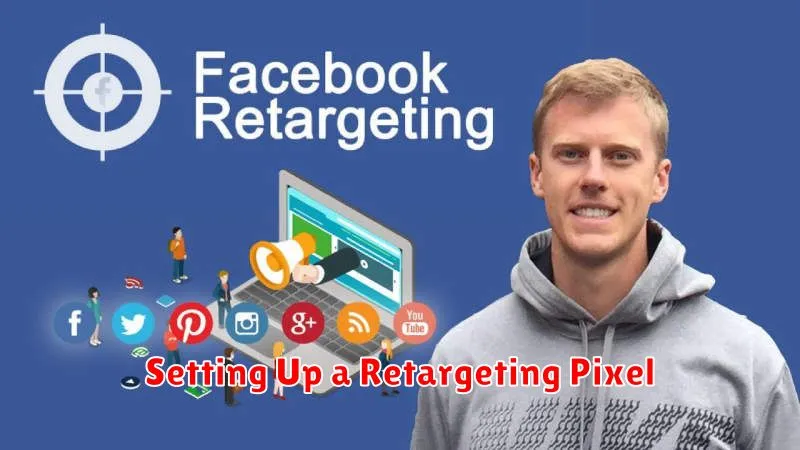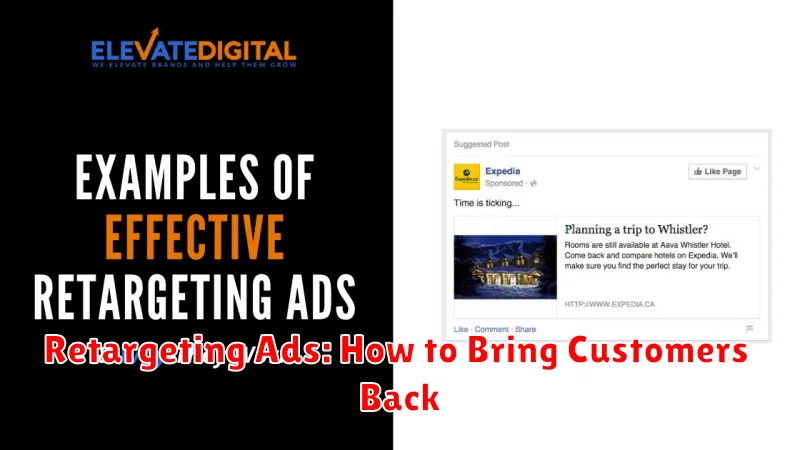Have you ever browsed a product online, left the website, and then suddenly started seeing ads for that exact product everywhere you go? That’s retargeting, a powerful digital marketing strategy designed to recapture the attention of potential customers who have shown prior interest in your products or services. Retargeting ads, also known as remarketing ads, strategically re-engage these “almost” customers, bringing them back to your website and guiding them through the sales funnel toward conversion. By leveraging retargeting strategies, businesses can significantly improve their return on investment (ROI) and maximize their advertising spend.
This comprehensive guide will delve into the world of retargeting ads, exploring how they work, why they are crucial for e-commerce success, and the most effective strategies for implementation. We will examine various retargeting platforms, discuss best practices for creating compelling retargeting campaigns, and provide actionable tips to optimize your ads for maximum impact. Learn how to effectively bring customers back to your site and transform them from window shoppers into paying customers with the power of retargeting.
What Is Retargeting?
Retargeting, also known as remarketing, is a form of online advertising that can help you keep your brand in front of bounced traffic after they leave your website. It allows you to strategically target ads towards people who have previously interacted with your brand, such as visiting your website, adding items to their cart, or viewing specific products. Essentially, retargeting allows you to re-engage these potential customers, reminding them of their interest and encouraging them to return and complete a desired action.
How does it work? Retargeting uses cookies, small pieces of data stored on a user’s browser, to track their online activity. When a user visits your website and performs a specific action, a cookie is placed on their browser. Then, when they browse other websites that participate in the same advertising network, your retargeting ads can be displayed to them, gently nudging them back towards your brand. This provides a powerful way to reconnect with interested prospects and turn them into paying customers.
Retargeting campaigns are highly effective because they focus on individuals who have already demonstrated an interest in your products or services. By showing them targeted ads based on their previous interactions, you significantly increase the chances of converting them into customers.
Retargeting vs Remarketing
While the terms retargeting and remarketing are often used interchangeably, subtle differences exist. Retargeting generally refers to reaching out to potential customers who have interacted with your brand online, but haven’t made a purchase. This often involves displaying ads for products they viewed or added to their cart across various websites and social media platforms.
Remarketing, on the other hand, is a more specific type of retargeting focused on re-engaging with existing customers. Remarketing campaigns often utilize email marketing to reach out to past purchasers with personalized offers, promotions, or product recommendations based on their previous purchase history. The goal is to foster customer loyalty and encourage repeat business.
In essence, retargeting casts a wider net, aiming to recapture lost potential customers, while remarketing focuses on nurturing existing relationships. Both strategies are valuable components of a comprehensive digital marketing plan, helping businesses maximize their return on investment.
Setting Up a Retargeting Pixel

Setting up a retargeting pixel is a crucial first step in any retargeting campaign. A pixel is a small piece of code that you place on your website. It’s invisible to visitors but allows you to track their behavior.
The process typically involves copying the pixel code provided by your retargeting platform (e.g., Google Ads, Facebook Ads) and pasting it into the header section of your website’s code. This usually requires access to your website’s HTML or using a tag manager.
Once installed, the pixel fires when someone visits your site. This action adds them to your retargeting audience list. When these users later browse other websites within the platform’s network, your ads can be displayed to them, reminding them of your products or services.
Important considerations include ensuring the pixel is placed on all relevant pages of your website to maximize its effectiveness. You should also verify its functionality after installation to confirm it is tracking visits correctly.
Segmenting Visitors for Better Ads
Segmentation is crucial for effective retargeting. It allows you to tailor your ads to specific groups of visitors based on their behavior on your website. This ensures your ads are relevant and engaging, leading to higher conversion rates.
Consider segmenting your visitors based on several factors. Page views can reveal product interest. For example, someone who visited several product pages for running shoes is likely interested in athletic wear. Shopping cart abandonment is a strong indicator of purchase intent. These visitors need a gentle nudge to complete their purchase. Past purchases are valuable for promoting related products or offering loyalty discounts. Finally, engagement metrics like time spent on site or pages per visit can identify highly engaged visitors who may be receptive to special offers.
By creating targeted segments, you avoid showing generic ads to all visitors. Instead, you deliver personalized messages that resonate with each individual’s interests and needs, increasing the likelihood of a conversion. This personalized approach makes your retargeting campaigns more efficient and profitable.
Crafting Ad Copy That Converts
Writing effective ad copy for retargeting campaigns requires a different approach than ads targeting cold audiences. Since you’re reaching out to individuals already familiar with your brand, your messaging needs to be more specific and action-oriented.
Acknowledge their previous interaction. Phrases like “Still thinking about it?” or “Welcome back!” can create a sense of familiarity and gently remind them of their interest. Highlight the benefits of your product or service, focusing on how it solves their problems or fulfills their needs. Don’t simply reiterate the general features.
Create a sense of urgency with limited-time offers, discounts, or promotions specifically designed for retargeting campaigns. A strong call to action is crucial. Use clear and concise language like “Shop Now,” “Learn More,” or “Get Your Discount” to encourage immediate action. Tailor your copy to the specific stage of the sales funnel the user is in. For instance, someone who abandoned their cart needs a different message than someone who just browsed your website.
Testing different ad copy variations is essential. A/B testing allows you to analyze what resonates most effectively with your target audience and optimize your campaigns for maximum conversions.
Using Frequency Caps
Frequency capping is a crucial element of retargeting campaigns. It limits the number of times your ad is shown to a specific individual within a given timeframe. This prevents ad fatigue, where overexposure leads to negative associations with your brand and wasted ad spend. Finding the right balance is key.
Too much exposure can irritate potential customers, driving them away rather than drawing them back. Too little exposure, and your retargeting efforts might not be effective enough to recapture their attention. A common approach is to start with a higher frequency in the initial days of a retargeting campaign and gradually decrease it as time goes on. This ensures initial impact without risking overexposure.
Optimal frequency caps vary depending on factors such as campaign objectives, industry, and target audience. Experimentation and monitoring campaign performance are essential to determine the most effective frequency for your specific situation. Analyze metrics like click-through rates and conversion rates to gauge how different frequency caps influence user behavior.
Retargeting on Facebook vs Google
Choosing between Facebook and Google for retargeting depends on your campaign goals and target audience. Each platform offers unique advantages.
Facebook excels at building brand awareness and engaging users higher in the sales funnel. Its detailed targeting options, based on demographics, interests, and behaviors, allow for highly personalized ads. This makes Facebook effective for re-engaging users who have interacted with your brand on the platform or elsewhere online. Think of it as reminding users of products they viewed or added to their cart.
Google, primarily through its Display Network, is better suited for targeting users lower in the funnel, actively searching for products or services. Google’s strength lies in its intent-based targeting, reaching users who have demonstrated a specific purchase intent. This allows you to recapture users who visited your website and researched specific products. Consider Google for targeting users who abandoned their shopping cart.
Ultimately, using both platforms in a coordinated strategy can often yield the best results, covering a wider audience throughout the purchasing journey.
Avoiding Ad Fatigue
Ad fatigue is a significant hurdle in retargeting. It occurs when your target audience is repeatedly exposed to the same ads, leading to decreased engagement and even annoyance. This can negatively impact your campaign performance and brand perception.
Frequency capping is crucial. This limits the number of times a specific user sees your ad within a given timeframe. Finding the right balance is key – enough exposure to reinforce your message, but not so much that it becomes irritating. Experiment to find the optimal frequency for your target audience.
Segment your audience. Create different ad variations for different segments based on their engagement level or stage in the sales funnel. This allows you to tailor your messaging and offers, keeping the content fresh and relevant.
Refresh your creatives regularly. New visuals, updated copy, and different ad formats can re-engage your audience and combat banner blindness. A/B testing various creatives can help determine what resonates best.
Expand your targeting. Broadening your reach to include new potential customers can prevent overexposure within your existing retargeting pool. This allows you to discover new opportunities while maintaining engagement with your core audience.
Measuring Retargeting Success
Measuring the success of your retargeting campaigns is crucial to optimize performance and maximize your return on investment. Key Performance Indicators (KPIs) provide quantifiable metrics to track progress and identify areas for improvement.
Begin by monitoring your click-through rate (CTR). A higher CTR indicates that your retargeting ads are resonating with your target audience and effectively driving traffic back to your website. Compare your retargeting CTR to your overall advertising CTR to gauge its relative performance.
Conversion rate is another essential metric. This measures the percentage of users who complete a desired action, such as making a purchase or filling out a form, after clicking on your retargeting ad. A strong conversion rate signifies that your retargeting campaign is successfully converting interested users into paying customers.
Return on Ad Spend (ROAS) is a key indicator of profitability. Calculate your ROAS by dividing the revenue generated by your retargeting campaign by the cost of the campaign. A positive ROAS demonstrates that your retargeting efforts are generating a profitable return.
Finally, track your cost per acquisition (CPA). This metric reveals the cost of acquiring a new customer through your retargeting campaign. By monitoring CPA, you can assess the efficiency of your campaign and identify opportunities for optimization.
Best Practices from Top Brands
Top brands leverage retargeting ads effectively by focusing on key strategies. Segmentation is crucial. They divide their audience based on behavior, such as product views, cart abandonment, and past purchases. This allows for highly personalized ads tailored to each segment’s specific interests.
Frequency capping is another important practice. Bombarding users with the same ad repeatedly can be detrimental. Top brands carefully control the number of times a user sees an ad within a given timeframe, preventing ad fatigue and maintaining a positive brand image.
Dynamic retargeting is often used to display ads featuring the specific products or services a user previously viewed. This personalized approach significantly increases the relevance of the ad and the likelihood of conversion.
Finally, A/B testing different ad creatives, copy, and calls to action helps optimize campaign performance. By continually analyzing and refining their retargeting strategies, top brands ensure maximum ROI.

